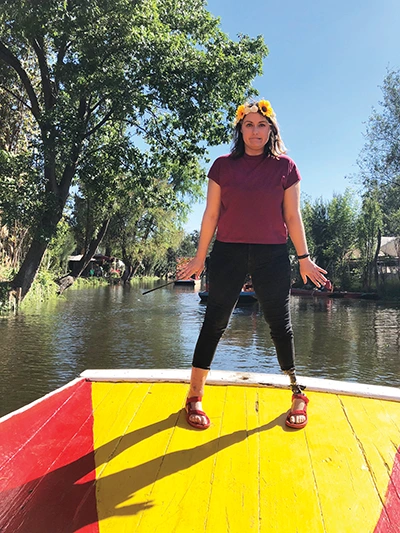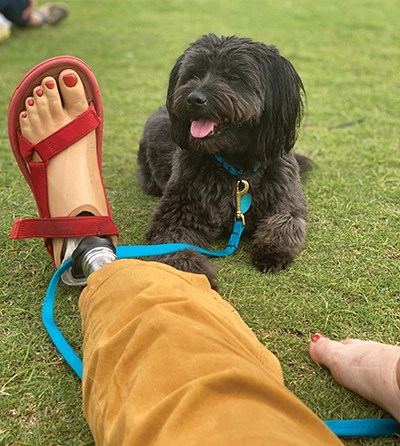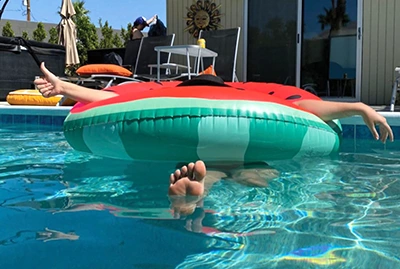My accident left me with two badly damaged legs. Should I try to save them? Or would amputation set me up for a better life?

courtesy Diana Theobald
By Diana Theobald
Every amputee has a story, and most of us have at least two versions. There’s the long version, shared only with special people. Then there’s the short one, ideally under five words long, that’s passed out like Halloween candy to every curious passerby who asks, “How’d you lose it?”
My short version: rock climbing accident. Depending on my mood, I might allow one or two follow-up questions, but that’s about as much of a narrative as you’re going to get.
In my long version, though, I bring up the choice—to amp, or not to amp? People sometimes underestimate what an excruciating choice it is. But anyone who’s been in that position, or any position where they had to make a big, crummy medical decision, knows that it’s a fraught thing. When people considering amputation ask me for advice, I like to joke, “Just cut it off.” But it’s never that simple.
Before my accident, here’s how I thought bodies worked: Brain makes choice; body obeys. Here’s how it actually seems to work: Brain makes choice; body does whatever it’s going to do, regardless of what brain says. Brain rationalizes what body does, convincing itself that whatever body did was actually a choice—and not just any choice, but the best choice. Because who wants to live with regret? Or worse, feel powerless against their own body?
At its core, my amputee story is about my brain—about me—coming to terms with what my body ended up doing. I have one amputated leg and one salvaged leg. These are the choices I made for each, and how each worked out for me.
The Leg I Lost
It all started when I fell 40 feet while rock climbing. I smashed both ankles and broke my back. I had the best of the best of orthopedic surgeons. He knew he could fix my right ankle. It would still be tough, but this was his specialty. He was less confident about my left ankle.

He waited a week or so before bringing up the A-word. When I first heard it, I was shocked. Amputate my leg? Who does that?
“Well, if it were me,” he said, “I’d want to amputate it so I could get back to work.” I thought he was insane, so brainwashed by capitalism that he would cut off his own leg for the sake of his job. Plus, his reasoning didn’t make any sense to me. How are you going to do anything, much less work, without a leg?
“Prosthetic technology has come a long way, especially in the past 20 years,” he explained. “You can do just about anything with a prosthetic leg these days.”
I wasn’t buying it. “Absolutely not,” I said. “I need to run. I need both ankles.”
“Your ankles are badly injured. You might be able to run, but I don’t think you’ll like it.”
“These are my ankles we’re talking about. If I want them to run, they will run.”
I was a pretty strong believer in manifestation and mind over body. I had absolutely no doubt that my ankles would heal, and I would return to the pristine condition I was in before my accident. I was really, really, really sure about that. Brain makes choice; body obeys.
At first, that’s what seemed to happen with my right ankle. My surgeon pinned all the pieces back together and neatly fused my sacrum. Good as new. Heading into surgery for the left ankle, his resident promised that she would make the scar as pretty as possible. Everything seemed on track.
After 17 hours of surgery, they woke me up. I was still intubated, my hands tied down to the hospital bed to prevent me from trying to rip the tube out of my throat. I promised I wouldn’t rip it out, so they untied me. Acting on its own authority, my hand immediately tried to rip the tube out. They retied my hands.
My mom was there with my best friend, Jackie. I couldn’t talk with the tube down my throat, so they gave me a pencil and a pad of paper to scratch out words. The doctors came in to explain what was happening. They had been putting the hardware into my ankle when the circulation in my left leg cut off. They did an emergency bypass, but it didn’t take. They were out of options. “We need to amputate,” they said.
“Really?” I wrote. “Your foot is black,” Jackie said.
“How high?” I wrote, asking where they would cut. The resident held her hand midway down her calf.
“Make it pretty,” I wrote.
And that was that. That’s how I chose amputation—or how amputation chose me.
The Leg I Kept
The first thing I noticed post-amputation was that the incredible pain I’d had in my left leg was gone. It came back a little, in the form of phantom limb pain, but that was nothing compared to what I’d been feeling before.

From then on, my left leg reached milestone after milestone of progress. In short order, I was ready to get fitted for my first prosthesis. But for that to happen, I needed to be able to stand up on my right leg. And my right leg, the one they’d fixed, did not want to obey.
My right ankle was infected. A patch of necrosis, dead skin, had formed. We cleaned it up and grafted on some new skin, but the infection came back weeks later, now in the muscle. We did a tissue flap, replacing the diseased tissue with a chunk from my back. Nine months later, I felt a crack while walking on the treadmill—the infection was back, now down to the bone. It had eaten away at two inches of my tibia. After seven months in an external fixator with heavy antibiotics, followed by a bone graft, I was finally done.
The last surgery on my left leg was the amputation in March 2015, one month after the accident. The final surgery on my right leg was in August 2016, just over 18 months later.
After the last operation, I wanted to try running again. I’d gotten a running blade from Challenged Athletes Foundation and was dying to use it. My surgeon had said my salvaged ankle probably wouldn’t like running, but I needed to prove to myself that I was still in control of my body.
My surgeon was right. My right ankle absolutely does not like running. She hates running. She barely tolerates walking. If I stand for too long, she whines about it for a day or two afterwards. On those days, she swells up and barks loudly when I try to bear weight on her. She makes me get out the cane for some old-fashioned hobbling. It’s the lack of cartilage, my surgeon said. I’ll be dealing with arthritis years before most of my peers. I can’t just lube up my flesh-and-bone leg with WD-40, like I do with my prosthetic leg.
To Amp, or Not to Amp?
At one point while I was battling the string of infections in my right ankle, I asked my surgeon if we could just cut it off and be done with it. This time, he thought I was insane. “I think you’re going to be happy you kept your right foot,” he said.
Here I am, eight years later. Am I happy I kept my right foot? Am I happy I lost my left one? Let’s compare the advantages to each in an illustrated chart:
AMPUTATED LEG
Appearance
Between covers and vinyl wraps, prostheses are works of art. No set of gams looks as cool as an Alleles cover. And the possibilities are endless. Socket wraps are like having a semi-permanent tattoo, but with brighter colors and much crisper graphics. We can wear our fandoms on our sockets. I love seeing kids’ legs covered in cartoon characters. Skin’s got nothing on carbon fiber.
Modularity
Your foot doesn’t run too well? Swap it out for a blade. Of course, blades aren’t cheap, and your insurance won’t pay for it because running isn’t “medically necessary.” You might need a grant from a nonprofit to help with the cost. But if you have enough cash and closet space, you can accumulate all sorts of specialized fittings for all sorts of purposes.
Heelworthiness
With the right components, you can wear any heel and your feet will never hurt. Again, this assumes you can afford the correct foot (insurance doesn’t consider heels medically necessary, either). I have the Freedom Innovations Runway foot, so I can wear a variety of heels up to 2.5 inches. Great, right? Trouble is, it’s hard to find cute heels under 3 inches. My right ankle isn’t mad about it, though—she’s only happy in a well-cushioned sneaker with inserts.
Lego resistance
Fake feet can’t feel pain or bleed, so you can leave your Legos all over the floor and they can’t hurt you. I’ve heard scientists are working on prosthetic feet that have feeling, though, so we should appreciate this feature while we can.
SALVAGED LEG
Flippy-floppies
Flesh feet don’t need shoes with backs so long as the toes can hold on. Fake feet, however, can only wear flip-flops with maximum-strength Velcro. It’s a good hack until the Velcro wears out and you lose your sandal. And because you can’t feel it slip off, you don’t realize it’s gone until someone points it out a mile later.
Metal detectors
I set these off everywhere—airports, courthouses, arenas, the occasional book signing or political rally. Security has no problem with flesh legs, even salvaged ones, but fake legs always need another look. Especially at the airport. TSA has been pretty good to me, though. I show a little leg, they show me through the 360 machine, swab, swab, swab, and I’m out. I sometimes miss just walking through, but at least I never have to take off my shoes.
Pedicures
No, I do not get half off. While it is nice that I don’t have to trim fake toenails or pumice fake heels, my fake feet don’t stay clean no matter what I do. They absorb dyes from shoes and dirt from floors, and no amount of alcohol, bleach, or acetone gets it off. And so much gunk takes up residence inside the foot shell! I haven’t been to the beach in over a year, but I still get sand in my face when I do a shoulder stand.
Yoga
Or balance in general. Through physical therapy, I’m getting better at balancing on my prosthetic leg, but I still topple over three times faster than I do when I stand on my salvaged leg. The glutes on my left leg have to do a job they weren’t designed to do. All the fine pieces of my right ankle might be damaged, but they innately know how to do the work.
The Verdict
The leg I lost and the leg I salvaged both impose restrictions of one kind or another. I know, I know—our brand as amputees is supposed to be “No Limbits!” “Unlimbited!” “Life Without Limbitations!” But the reality is, there are limitations. That goes for both prosthetic and salvaged limbs. Most days, my salvaged limb is what holds me back. It limits the distance I can walk and the intensity of my workouts. It throbs and cracks and swells. But even on a bad ankle day, I can still hobble.
I can’t even do that on the days when my amputated leg holds me back. It happens very infrequently, maybe once a year. It could be that I fell and bruised it, or maybe I developed a sore or skin infection—whatever it is, if I can’t wear my prosthesis, walking is off the table. My right foot can’t handle crutching solo, so I use my wheelchair. Wheelchairs are great, but there are still lots of places that aren’t accessible to them, and that bites.
So, taking it all into account: Am I happy I kept my right foot? I am. Am I happy I lost my left foot? I also am. Would I still be happy if I’d salvaged both ankles, or amputated both and got to pick a different shoe size? Probably. There are pros and cons to every choice, and like I said: Who wants to live with regret?
The real question is: Am I at peace with my body, or does it still feel like a separate entity that works against me? Do I still think in terms of my brain controlling my body, or my body disobeying my brain? Do I struggle to reconcile that my body and my brain—together—are me? Am I at peace with myself?
I don’t think I am just yet, but I’m getting there. That part of my amputee story is still being written.
Diana Theobald is a content diversity consultant. She has held roles in creative development and diversity & inclusion at Warner Bros. Discovery, Marvel, DreamWorks Animation, and NBCUniversal.




